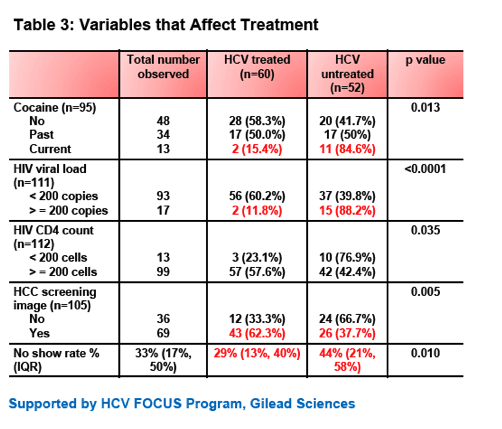 |
 |
 |
| |
Barriers to Hepatitis C Treatment in HIV co-infected Patients in the Era of New Direct-Acting Antiviral Therapy (Philadelphia): Just Over Half With HCV/HIV at Academic Center Get DAAs for HCV
|
| |
| |
Just Over Half With HCV/HIV at Academic Center Get DAAs for HCV
IDWeek2017/IDSA, October 4-8, 2017, San Diego
Mark Mascolini
Just over 50% of HCV/HIV-coinfected people in care at a Philadelphia academic center got treated for HCV with direct-acting antivirals (DAAs) in 2016 [1]. A detectable HIV load and substance abuse emerged as apparent barriers to DAA therapy.
HCV is highly prevalent in HIV populations and worsens overall prognosis of coinfected people. Although DAAs transformed treatment of HCV infection and yield similar cure rates in HCV/HIV-coinfected and HCV-monoinfected individuals, large fractions of coinfected people have not received DAAs. For example, among 876 coinfected people in Switzerland seen in the second-generation DAA era, only 180 (20.5%) got DAA therapy [2]. Yet the cure rate jumped from 55% in the pre-DAA era, to 70% with early DAAs (only boceprevir and telaprevir), to 96% in the second-generation DAA era.
To get a better grasp of DAA uptake in coinfected people and barriers to DAA use, researchers at Philadelphia's Drexel University clinic retrospectively analyzed data from coinfected patients seen during 2016. To identify potential obstacles to DAA therapy, they compared DAA-treated people with those who remained untreated.
The analysis included 115 people, 32 of them (28%) women. Two thirds of these people (68%) were black, 18% white, 13% Hispanic, and the rest Asian. Only 6% had private insurance; the rest relied on Medicaid (66%) or Medicare (25%) or had no insurance (3%). More than half (60%) had psychiatric illness, 46.5% had hypertension, and 16% had diabetes. Six people (6%) currently injected drugs, while 44 (42%) had an injecting history. Current and past cocaine or alcohol affected sizable minorities of the cohort.
Only 2 people were not taking antiretroviral therapy, but 17 (15%) had an HIV load above 200 copies. Among people with HCV treatment information, 61 (53.6%) got DAAs and 52 (46.4%) did not. Forty-three of 97 (44.3%) had F3 or F4 fibrosis.
Among people who had not taken DAAs, 36% were about to start soon, 20% had uncontrolled HIV infection, 13% actively used drugs or alcohol, 9% had more urgent health problems, 4% had unstable housing, 2% had insurance barriers, and the rest had other reasons for not starting DAAs. People who had not taken DAAs differed significantly from those who had in five ways:
-- Current cocaine use: 84.6% versus 15.4%, P = 0.013
-- HIV load above 200 copies: 88.2% versus 11.8%, P < 0.0001
-- CD4 count below 200: 76.9% versus 23.1%, P = 0.035
-- Appointment no-show rate: 44% versus 29%, P = 0.01
-- Hepatocellular carcinoma screening: 37.7% versus 62.3%, P = 0.005
The Drexel team offers two suggestions to overcome barriers to DAA care: (1) Provide support and resources to help people stop using cocaine, and (2) encourage frequent follow-up to achieve HIV suppression.
References
1. Deering C, Coppock D, Boyle S, et al. Barriers to hepatitis C treatment in HIV co-infected patients in the era of new direct-acting antiviral therapy. IDWeek2017/IDSA. October 4-8, 2017. San Diego. Abstract 2233.
2. Beguelin C, Suter A, Bernasconi E, et al. Trends in HCV treatment uptake, efficacy and impact on liver fibrosis in the Swiss HIV Cohort Study. Liver Int. 2017 Jul 25. doi 10.1111/liv.13528. Epub ahead of print.
----------------------------

Barriers to Hepatitis C Treatment in HIV co-infected Patients in the Era of New Direct-Acting Antiviral Therapy
Caytlin Deering1, Dagan Coppock1, Suzanne Boyle2, Zsofia Szep1, Taneesa Franks1, Tiffany Scott, 1, Anna Kesaris1, Edgar Chou3and Dong Heun Lee1,
Division of Infectious Diseases and HIV Medicine, (2) Division of Nephrology, (3) Department of Medicine, Drexel University College of Medicine, Philadelphia, PA



|
| |
|
 |
 |
|
|